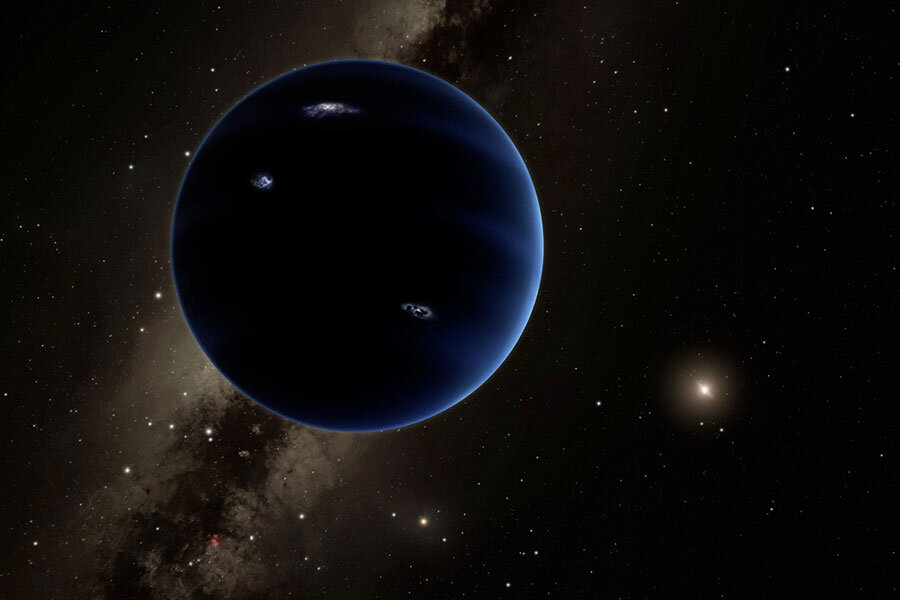Is there a ninth planet? The evidence is growing.
Loading...
The case for Planet Nine's existence keeps getting stronger.
Astronomers have discovered several more objects in the extreme outer solar system whose orbital characteristics hint at the existence of an unseen "perturber" in the dark depths far from the sun — a hypothetical world larger than Earth that scientists are calling Planet Nine, or Planet X.
"If you want to put a number on it, I'd be somewhere like 80 percent sure that there's a Planet X out there," said Scott Sheppard of the Carnegie Institution for Science in Washington, D.C., lead author of a new study announcing the new objects' discovery. [Evidence Mounts for Existence of 'Planet X' (Video)]
"I don't think it's a slam dunk; it's not 100 percent, because it's such low-number statistics," Sheppard told Space.com. "But there are a lot of strange things that seem to be going on that would be explained quite well with there being some kind of massive planet out there."
An undiscovered planet?
Sheppard performed the new study with Chadwick Trujillo, of the Gemini Observatory in Hawaii. The two researchers first inferred the possible existence of Planet Nine back in 2014, after analyzing the highly elliptical orbits of the dwarf planet Sedna and a new object they spotted, known as 2012 VP113 (and nicknamed "Biden").
Both bodies inhabit the far outer solar system. Sedna and 2012 VP113 lie an average of 506 and 259 astronomical units (AU) from the sun, respectively; it takes Sedna about 11,400 Earth years to complete one lap around the sun. (One AU is the average distance from Earth to the sun — about 93 million miles, or 150 million kilometers.)
In their 2014 study, Sheppard and Trujillo noted that Sedna, 2012 VP113 and several other extremely distant objects share certain orbital characteristics, and suggested that these bodies' paths around the sun may have been shaped by a large planet in the region — a world two to 15 times more massive than Earth that lies hundreds of AU from the sun.
This hypothesis was bolstered earlier this year, with the publication of a study by astronomers Konstantin Batygin and Mike Brown, both of the California Institute of Technology in Pasadena. The duo's computer simulations suggested that the gravitational influence of a roughly 10-Earth-mass planet about 600 AU from the sun could indeed explain the odd "clustering" in the orbits of Sedna, 2012 VP113 and a handful of other distant objects.
The sample size of such putatively affected bodies has always been small, but it's getting bigger. ['Planet 9' May Have Been Part Of A Cosmic Heist, If It Exists (Video)]
The evidence mounts
For the past few years, Sheppard, Trujillo and David Tholen of the University of Hawaii have been hunting for objects in the far outer solar system using several different instruments, including the Subaru Telescope in Hawaii and the Dark Energy Camera, which is installed on a 4-meter telescope at the Cerro Tololo Inter-American Observatory in Chile.
The new study, which has been accepted for publication in The Astronomical Journal, reports this survey's latest finds.
The astronomers discovered several dozen previously unknown bodies, including a roughly 155-mile-wide (250 km) object called 2013 FE72 that gets an incredible 4,000 AU from the sun at its most distant point. That puts it out in the outer Oort Cloud — the realm of comets.
"Its orbit is probably controlled and highly perturbed by outside forces, such as other stars and things like that," Sheppard said.
They also discovered two 125-mile-wide (200 km) objects, known as 2014 SR349 and 2013 FT28, that "cluster" in one of the key orbital parameters (known as argument of perihelion), furthering strengthening the case for Planet Nine's existence. (The objects' names reflect the years that they were first spotted in the survey; their discovery is being announced in the new study.)
"We have 15 or so of these extreme objects now, and all of them cluster in this argument of perihelion angle," Sheppard said.
Furthermore, he added, the five most distant of these 15 extreme objects share similarities in another orbital characteristic as well, one called longitude of perihelion. Significantly, the far-flung five are too distant to be realistically affected by any gravitational tugs from Neptune (whose influence could be the reason the other 10 objects' longitudes of perihelion don't line up).
It would take just two or three more such additional finds to put Planet Nine on solid ground, Sheppard said.
"I think statistics-wise, in the next year to two years we'll probably find enough of these small, extreme objects to really say if Planet X exists or not," he said.
Getting a look at Planet Nine?
Finding Planet Nine via a blind search would be incredibly difficult and time-consuming. The putative world, while big, would also be quite faint because of its immense distance from the sun. The planet's huge and as-yet-undetermined orbital path also means it could be hiding anywhere along a large swath of sky.
But Brown has said that Planet Nine may well be visible through powerful telescopes, provided astronomers point them in the right direction at the right time. And the ongoing survey Sheppard and his colleagues are performing should help researchers do that.
"We need like 10 or 20 of these smaller extreme objects, and we can probably nail down much better where Planet X would be out there," Sheppard said.
Follow Mike Wall on Twitter @michaeldwall and Google+. Follow us @Spacedotcom, Facebook or Google+. Originally published on Space.com.
Editor's Recommendations
- Planet X May Be Real - Evidence Mounting For 9th Planet | Video
- 'Planet Nine': Facts About the Mysterious Solar System World (Infographic)
- Dwarf World 2012 VP113 at Solar System's Edge: Photos and images
Copyright 2016 SPACE.com, a Purch company. All rights reserved. This material may not be published, broadcast, rewritten or redistributed.







